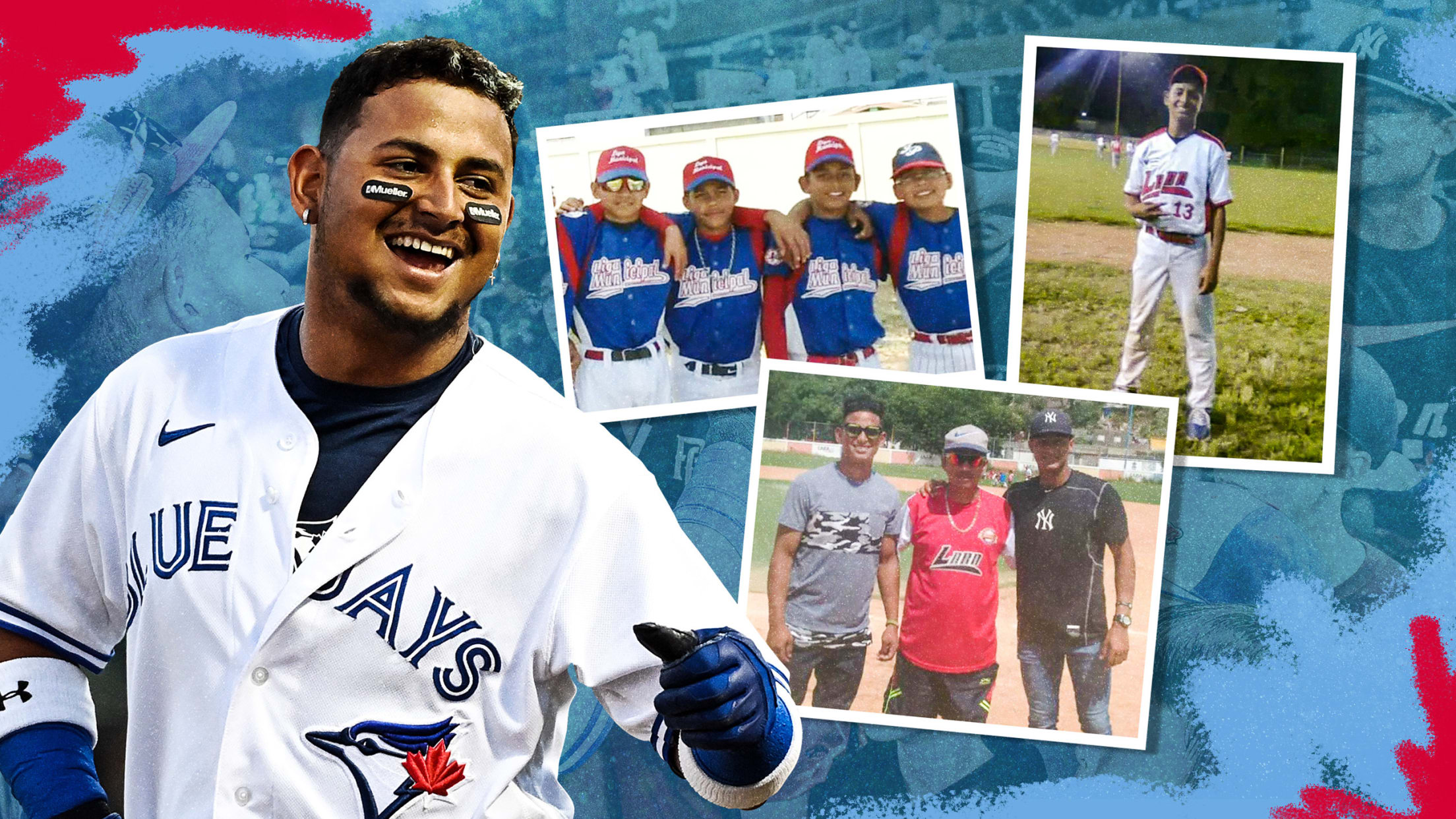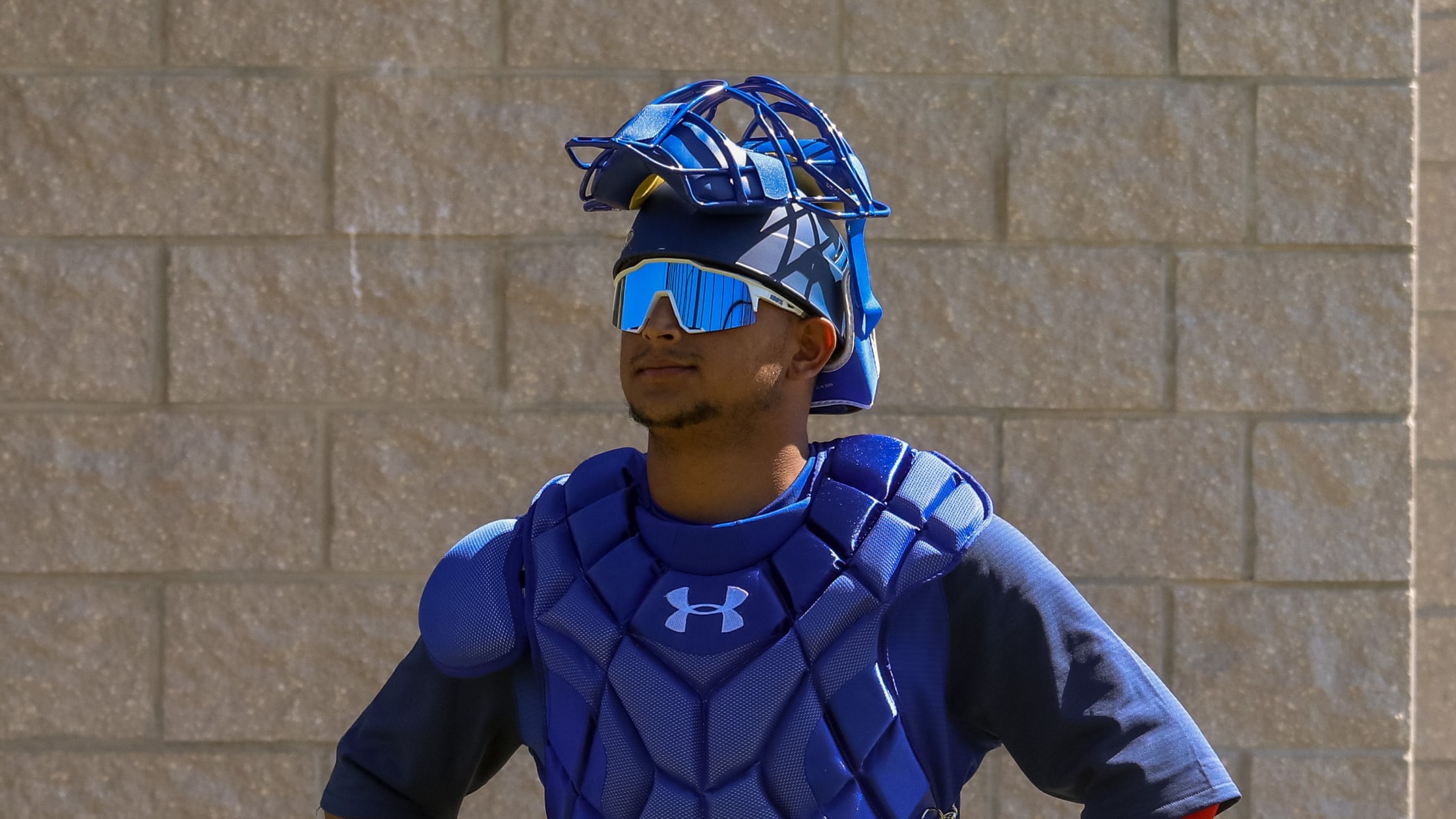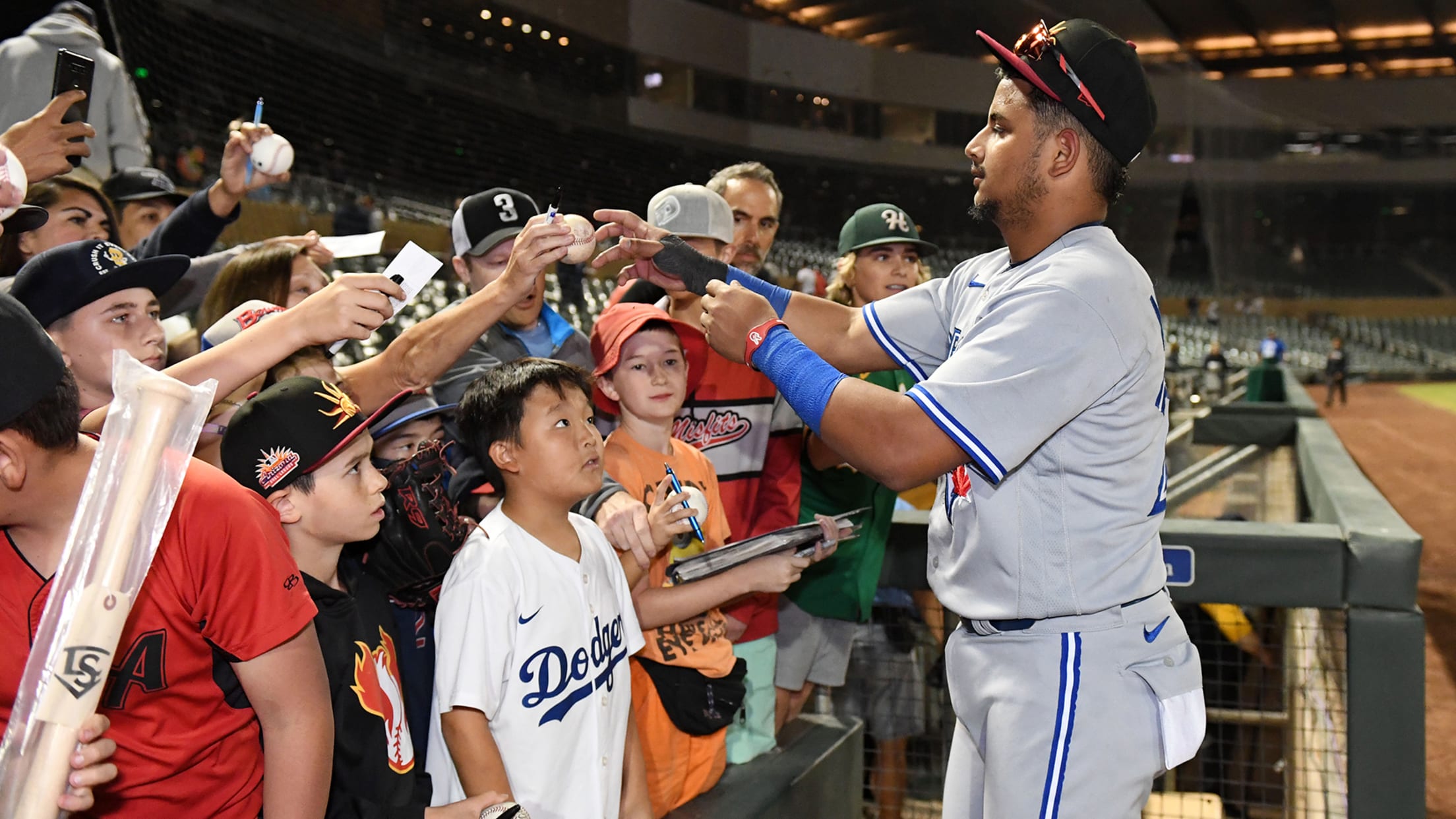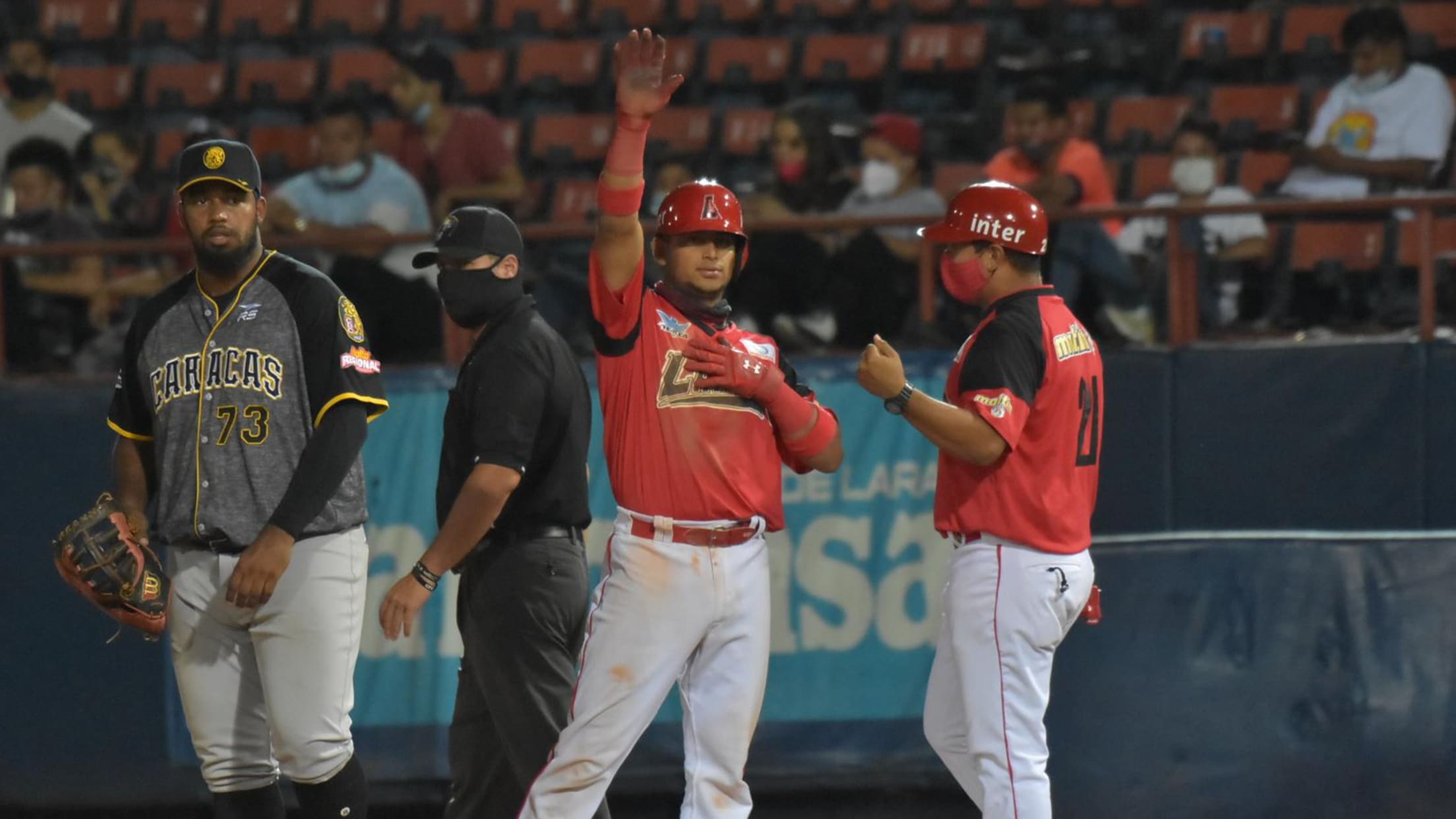
From Venezuela to top prospect, Moreno's journey guided by family
This story was originally published June 8, 2022, and has been edited to reflect the December 2022 trade between the D-backs and Blue Jays which sent Gabriel Moreno to Arizona.
One of Gabriel Moreno’s earliest baseball memories is retiring. He was eight or nine years old and had no other choice.
Moreno’s family couldn’t afford to keep him in organized baseball in Venezuela. Instead, he played soccer in the streets of Barquisimeto, which is where his baseball story could have ended.
Instead, Moreno first became one of baseball's brightest young prospects in the Blue Jays' system, and is now entering his age-23 season as a D-back after the trade that sent he and Lourdes Gurriel Jr. to Arizona and Daulton Varsho to Toronto. He’s now gone from a $25,000 signing in August of 2016, a routine addition that mostly didn't register at the time, to a certified bright spot who put up seven RBIs with a 111 OPS+ over 25 games after making his debut in June.
Where the star catcher stands now is not where the arrows always pointed. It was Moreno, his family and the community that lifted him, which all led to this moment, and the many opportunities he will have to shine in the years to come.
This is the story of Gabriel Moreno.

The Kid from Barquisimeto
To understand Moreno’s journey, you must first understand the Venezuela he was born into in 2000, the youngest of four children.
Food shortages and extreme poverty began to take hold of Venezuela in the late 2000s, furthered by a country-wide energy crisis that contributed to the nation’s ongoing economic decline.
Moreno’s family didn’t get through that time unscathed. His father, José Moreno, worked in street paving in their native Barquisimeto and its surrounding areas. When the crisis hit, everyone’s priorities shifted quickly.
“My dad wasn’t making much money,” said Moreno. “He couldn’t find much money, and when he did, it was for food, not for baseball.”
What looked like the end of a childhood hobby, though, was soon resurrected as the beginning of a big league dream by a man who eventually became family to Moreno. Jose Mejia, the president of 12 de Octubre, a local baseball school, was one of the first people to believe in the promise of Moreno’s bat, taking him under his wing and putting him back on the field when he was 11.
“He picked me up, dropped me off, made everything easier for me,” said Moreno. “He helped me return to baseball. Thanks to him, I was able to go to the academy that signed me. I’m so grateful for him. Whenever I see him, I ask for his blessing. He’s been like a father to me and his whole family has helped me so much.”
Mejia understood the reality of the Moreno family and what it would mean to let Gabriel’s promise disappear in a time of scarcity. Unwilling to let that happen, Mejia would lodge Moreno in his house for days at a time, essentially welcoming him into his own family.
“Every tournament was an expense for his dad,” said Mejia. “... Of course, at that time, the mindset was different. The economic situation was unfavorable. Since I was always around the baseball world, I wanted to help in any way I could.
“He was like a son to me, and I was like his father at that moment.”
When I was in Venezuela, all I wanted was to be called to play in the Dominican and play ball, because I wanted to help my family forward. Truthfully, it was a difficult time, because I was very attached to my dad and my family. It was difficult, but little by little I got used to it. Because someone who has this much love for this ball has to make lots of sacrifices.
Gabriel Moreno
José Moreno, in the meantime, continued to support his son in any way he could -- even if that involved Gabriel being away from home, spending his days with another family.
“He worked so hard,” said Gabriel of his father. “He always did everything in his power so I could play baseball. My dad is the best for helping me keep my focus on the game.”
That focus started to pay off when Gabriel gained more recognition in Venezuela -- something Mejia had set as a goal from the start.
“He couldn’t stay hidden.”
At 12, Moreno joined Carlos Torres’ Champions Baseball Academy, according to Mejia. He was one step closer to the end goal.
“When I was in Venezuela, all I wanted was to be called to play in the Dominican and play ball, because I wanted to help my family forward,” said Moreno. “Truthfully, it was a difficult time, because I was very attached to my dad and my family. It was difficult, but little by little I got used to it. Because someone who has this much love for this ball has to make lots of sacrifices.”
Uncovering the hidden gem
Everyone involved in his journey remembers their first Gabriel Moreno story.
Andrew Tinnish, the Blue Jays’ VP of international scouting, remembers hearing early reports from Francisco Plasencia, who played professionally for a decade before joining Toronto as a scout.

All of these stories share the same asterisk, though. Moreno wasn't actually the player they were expecting to scout.
“Depending on the size of the academy, they may have 10-12 [players] or 30-40 with different age groups, different classes,” Tinnish explained. “Often, you’re going to go in and an agent is going to showcase specific guys. They’ll put out a small group, maybe two or three standout guys. That’s who you’ll see take the bulk of the live at-bats if they play some type of game. Gabriel was not in that group.”
Instead, Tinnish remembers, Moreno made himself part of it.
These priority groups typically needed another hitter to round out the group, or an extra bat to face a pitcher that scouts were there to see. Every time Plasencia looked, he saw Moreno running to the front of that group. He proved he belonged, driving the ball to all fields and showing a natural hitting ability that kept Plasencia watching.
Parts of this are his athleticism, his vision and his coordination, but the absolute most significant piece of this is his upbringing.
Blue Jays GM Ross Atkins
Still, Plasencia wanted to take this a step further. It’s easy for young players to seem eager on a day they know their academy’s bleachers will be littered with MLB scouts. They’re coached for years to perform in that exact moment, not just at the plate but with every step they take in front of scouts.
That’s when Plasencia planned to return in secret. On a day Moreno didn’t expect scouts to visit, Plasencia was tucked away, watching.
“I saw this kid cleaning the field, helping to bring in all of the balls from BP to the pitcher. I never see that. I was a player for 10 years and I’d never seen a player do that,” Plasencia said. “If he knew I was there? Sure. But I’d been there a couple of times without telling anybody. I saw this kid doing the same thing every day for three or four days. I talked to the groundskeeper there, and he said, ‘Yes. This kid has done this every day since he got to this academy.’”
Even for a one-time top five prospect, this is how all of the stories begin. Not with the player, but the person.
“Parts of this are his athleticism, his vision and his coordination, but the absolute most significant piece of this is his upbringing,” said Blue Jays GM Ross Atkins. “He’s also an exceptional listener, which I find to be a great attribute of talent.”

This was the determining factor for Plasencia, too. Signing 16-year-olds is all about projecting the growth of physical talents, but these are still boys growing into men. With trust in Moreno the person, his belief in the physical tools only grew, which again Plasencia brings back to Moreno’s family.
“They’re the kind of people that, it doesn’t matter if they have money or not, they’re still the same. For me, that family is unique,” Plasencia said. “This kid has that on his heart and his mind. For me, that’s why he’s so good. What touched me the most, and the most important thing to see in a player, is for him to do all of this and be the same as he was six or seven years ago.”
Certain in what he saw, Plasencia brought in Sandy Rosario, the Blue Jays’ director of Latin American operations, for a longer look. Moreno was a middle-infielder at the time, but the Blue Jays wanted to see him step behind home plate and make some throws. Those throws hit the mark, so when Rosario came to town, they put Moreno in catcher’s gear.
That Monday was rough. Moreno looked like a young kid wearing gear he’d never worn before, but by Tuesday, he was already looking better. At this point, Plasencia and Rosario knew three things. Moreno could hit, he had natural talent to work with and he wanted to be better. That was enough, so a $25,000 contract was signed.
Around when Moreno signed, he was in the middle of playing a state tournament on a club with Mejia, who’d done so much to get him to that moment. Moreno had to stop playing initially after the deal was signed, but it was a long tournament, stretching over a couple of months, and eventually, Moreno’s agent gave Mejia a call and said that Moreno was cleared to play in the final games of the tournament.
Mejia slotted his unofficial son back into the lineup.
“His first at-bat, at 3-0, he hit it out of the park as if he were a grown man,” Mejia remembers. “From then on, his steps as a professional player began.”
Developing a star
Moreno enjoyed some early success as an 18-year-old in the Rookie GCL and Appalachian League, but his full-season debut with Single-A Lansing in 2019 put him squarely on the radar.
On that Lugnuts team was Jordan Groshans, once the Blue Jays’ No. 3 prospect and now on the Marlins. Groshans came up through the system with Moreno, including the ‘21 season with Double-A New Hampshire where Moreno hit .373 with eight home runs and a 1.092 OPS in just 32 games before breaking his left thumb. That surge skyrocketed him up prospect rankings.
“I’m just so proud of him. He’s like a brother to me. It’s really good to see how much love he’s getting, how much support he’s getting and how far he’s come,” Groshans said. “Everybody else knows how much of a superstar he is, but it seems like he doesn’t. It’s normal for him. He shows up, goofy, laughing and joking around with his teammates, then goes out and goes 4-for-4 like it’s nothing. He’s just a joy to be around and a great teammate.”
Coaches echoed Moreno’s teammates throughout the Blue Jays’ system. He left an immediate impression playing winter ball with Cardenales de Lara in Venezuela for two offseasons, during which he met and played under Carlos Mendoza, the bench coach for the New York Yankees.
“He walked into that clubhouse in the middle of a year and fit right in,” Mendoza said. “It was just another guy in the clubhouse. His interactions with his teammates, joking around. And when they were pulling for him, that tells you a lot about the person Gabriel is. He was special.”
During the 2021 offseason, Moreno was with Lara as a DH, getting him more at-bats after a shortened season. What Mendoza remembers, though, is finding Moreno at the field early every single day, going through drills as a catcher and third baseman even though he wouldn’t be playing defensively.
“This is a guy that is a No. 1 prospect,” Mendoza explained of that period. “Everybody talks about him coming from the Fall League, and he walks into a clubhouse full of veterans, guys from all over. And he was just very humble, he listened, very respectful. Credit to his parents for raising a great kid and the Blue Jays for continuing to do that. Very humble, very quiet, willing to learn, asking good questions.”

In Triple-A Buffalo last season, Moreno played under manager Casey Candaele, who’s seen it all after 18 professional seasons, including nine in the Majors before moving on to coach with the Mariners, Rangers and Blue Jays.
Candaele remembers his Moreno moment, too. It was a throw.
With a runner at second base, Moreno picked a slider out of the dirt with a lefty in the box, dragging the catcher behind the hitter’s body. The baserunner broke for third, thinking the ball would get past Moreno, but he managed to keep it in front of him. Moreno twitched his body away from the hitter to create a throwing path, but immediately saw his own pitcher was in the way, so he made a second adjustment to throw around both players. The throw was a rocket, the runner was out. And it all happened in a split second.
“I asked him what he was thinking, and he explained exactly what transpired,” Candaele remembers. “Just to be able to do that in the moment is pretty instinctually advanced. That’s something that, when it happened, I stopped and said, ‘Man, that’s special.’"
Soon enough, everyone will have their first big league story with Moreno. He has the potential to be a franchise cornerstone in Arizona, growing old and chasing championships alongside new teammates like Corbin Carroll (the D-backs' No. 1 prospect) and Alek Thomas.
When that moment comes, Moreno will think of his father, mother and three older siblings. He’ll also think of Mejia. He’s family, too.
“I have no words. I have two sons and he’s like the third,” Mejia said. “He’s such a humble kid, so honest, hard-working. He carries his values at the root of his humility. And with everything he’s accomplished, it hasn’t changed the way he sees the world. He’s still the same ball player and the same person. As a person, I can guarantee it, he’s better than as a ball player. So, imagine how great that is.”
That moment will bring an ending and a beginning. Far from Barquisimeto, where Moreno played soccer on streets paved by his father, he’s building on the many moments that almost never were.
“If I tell this story, no one believes me.”
